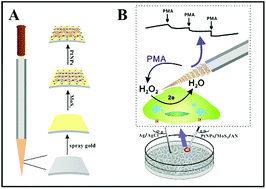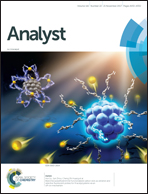MoS2/Pt nanocomposite-functionalized microneedle for real-time monitoring of hydrogen peroxide release from living cells†
Abstract
This work describes the adaptive use of a conventional stainless steel acupuncture needle as the electrode substrate for construction of a molybdenum disulfide (MoS2) and platinum nanoparticles (PtNPs) layer-modified microneedle sensor for real-time monitoring of hydrogen peroxide (H2O2) release from living cells. To construct the nanocomposite-functionalized microneedle, the needle surface was first coated with a gold film by ion sputtering to enhance the conductivity. Subsequently, an electrochemical deposition method was successfully employed to deposit MoS2 nanosheet and Pt nanoparticles on the needle tip as the sensing interface. Electrochemical study demonstrated that the MoS2/PtNPs nanocomposite-modified needle exhibited excellent catalytic performance and low over-potential toward the reduction of H2O2. Not only did the microneedle achieve a wide linear range from 1 to 100 μmol L−1 with a limit of detection down to 0.686 μmol L−1, but it also realized the highly specific detection of H2O2. Owing to these remarkable analytical advantages, the prepared microneedle was applied to determine H2O2 release from living cells with satisfactory results. The MoS2/PtNPs nanocomposite-functionalized microneedle sensor is simple and affordable, and can serve as a promising electrochemical nonenzymatic sensing platform. Moreover, this superfine needle sensor shows great potential for real-time monitoring of reactive oxygen species in vivo with minimal damage.

- This article is part of the themed collection: Recent analytical chemistry science from China


 Please wait while we load your content...
Please wait while we load your content...